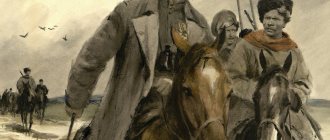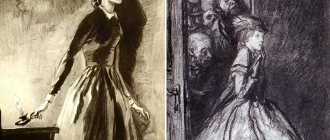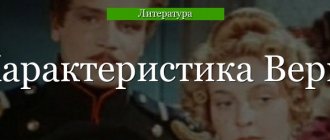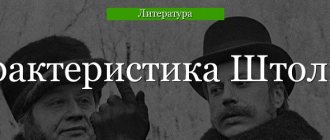- Essays
- On literature
- Sholokhov
- The image and characteristics of Evgeny Listnitsky in the novel Quiet Don
Listnitsky is one of the characters in Sholokhov’s novel Quiet Don. He is of noble origin, a landowner. The estate he owned was called Yagodnoye, and was located not very far from the Tatar capital.
Eugene's father is a fairly respected and noble man, from a majestic family. He took part in the Russian-Turkish war and was its hero. After the war, he began to lead a more relaxed lifestyle and started farming. He sent his son to the cadet corps.
Listnitsky was a participant in the First World War, and later in the revolution. He shared the positions of whites. At that time he was a “farm intellectual” and supported the tsar in everything. Eugene was loyal to the tsar and his power and supported his interests in everything. For him it was a kind of meaning of life. He was completely delighted when he was lucky enough to meet the emperor himself. Evgeniy took all the gossip and insults against the government with hostility. After the revolution, I had a hard time with all the innovations of the Soviet government.
Listnitsky is a young officer, good-looking. His height was short, his forelock was always combed to the right side. His distinguishing feature when speaking was that he squinted his gray, piercing eyes.
Such minor characters as Grigory and Aksinya worked on Listnitsky’s estate. For some time, young Evgeny really liked Aksinya, and a romance began between them.
Evgeniy was a courageous soldier; he was wounded several times in 1917, but quickly returned to duty. He decided to spend his vacation with his friend Gorchakov. It was there that Listnitsky met his friend’s wife, whom he married after Gorchakov’s death.
It was Eugene who tried to cope with injustice. He was the last to see the emperor who abdicated the throne. The most shameful thing for him was that a person like Nicholas 2 was seen off in silence. He didn’t want to believe it, he was too devoted to the system of that time.
In general, Evgeny Listnitsky can be called a positive and important character in the novel Quiet Don. After all, it was people like him that Russia needed back then. The most offensive thing is that at that time there were very few of them. There were few truly loyal soldiers who were ready to follow their emperor to the end. Most succumbed to secular power.
Option 2
Sholokhov wrote a lot of different and interesting works and “Quiet Don” is no exception. There are a huge number of heroes here, and Zhenya Listnitsky became one of the minor heroes. His parents were nobles. And since his father was in the army, his son should follow in his footsteps. After the army, he began to lead a quiet life and do housework. That is why after school the guy went to work in the cadet corps.
The man was short and had a heavy build. In order to examine any objects, he needed to come very close. He had his own large estate, which was located in the village of Yagodnoye. He helped and supported the king in everything, and also helped him solve certain problems. Of course, many villagers did not agree with what the government decided or did, and so they spread or told each other different stories, and added a little of their own history. And Zhenya didn’t even like all this. He tried to make sure that all these conversations ended as soon as possible. He also didn’t like how the government was changing and what demands it was making on residents.
Besides him, Aksinya and Grigory worked here. Gradually, Zhenya realized that he really liked this woman, although he had pushed all this away from himself for a long time. A little later, they could no longer resist the surging feelings and therefore began to meet secretly.
And after some time, he joined the ranks of the whites, and he did all this only to be always close to the ruler and help him, and also to be useful to him. During the battle he was wounded and soon had to have his arm amputated. At first it was very difficult for Zhenya to get used to this, but over time he came to terms with it. A little later, his best friend died, and since he still had a wife, he decided that he would marry his wife and would help her in everything. In addition, he had been in love with her for a long time, but he did not want to go against his friend. He brought his new wife to his estate and tried to help her in everything and in no way humiliate her, as he did with his previous wife.
He constantly fought against injustice and saw it everywhere. In addition, he did not believe that Nicholas would secretly leave his throne, and until the last he was confident that the ruler would change his mind and remain in his place.
If we classify Listnitsky as a positive or negative hero, then he most of all belongs to the positive, because the country needed people like him.
When the war ended, they moved to another city, where they began to live completely differently. It was there that Aksinya found a lover and now began to meet with him secretly. And when the hero himself found out about this, he could not survive it. He saw the only correct option in this situation as death.
Essay on the topic Evgeny Listnitsky
Evgeny Nikolaevich Listnitsky in Sholokhov’s novel “Quiet Don” is one of the minor, but no less interesting characters.
This is a young man of noble noble origin, the son of a landowner. Together with his father, he lived on the Yagodnoye estate, near the Tatar village. His father, a noble and respected man, a former participant in the war between the Russians and the Turks, bears the title of hero. After retirement, he began to engage in agriculture and lead a measured and calm life. Evgeniy studied in the cadet corps.
Outwardly, Evgeniy was an ordinary man, of average height and build. Since the young man had poor eyesight, he wore pince-nez. In those days there was a fashion for Cossack forelocks and the centurion also kept up with this. Evgeniy had brown hair and light eyelashes.
Grigory and Aksinya came to live and work on their estate before the war began. When Gregory was taken away to fight, and then Aksinya’s daughter died and the woman was in a difficult moral state, Evgeniy took advantage of this. He became intimate with Aksinya. Then, of course, he paid for his behavior. Grigory took cruel revenge on him.
Eugene deeply respected his emperor and was proud of his noble origins. He became very angry if suddenly negative remarks were made towards his sovereign. His patriotism went so far that he asked for a transfer from the Life Guards, since no one shared his views regarding the emperor. It was a heavy blow for Listnitsky to learn that his idol, the monarch, had abdicated the throne. He was indignant that the common people accepted this and did nothing.
In 1916, Lisnitsky was given the rank of captain. Eugene was against a civil uprising; he had a negative attitude towards both the Bolsheviks and the Social Democrats. At the end of the First World War, Eugene wants to be closer to the sovereign and joins the White Party.
A man is ready to sacrifice the most precious thing - his life, just to defend his position no matter what. In the battle between the Whites and the Reds, Evgeniy was seriously wounded and had to have his arm amputated. Gradually, looking at the situation soberly, captain begins to understand the inevitability of the Reds’ victory. No matter how much he wanted to, he had to come to terms with it.
Listnitsky fell in love with his friend’s wife, Olga Gorchakova. And after the death of her husband, Eugene married a young widow. The man was an honest and open person, he treated his wife with warmth and love. When they settled on his estate, Eugene asked Aksinya to move out.
The fate of Evgeny turned out to be as tragic as most of the fates of Sholokhov’s great work “Quiet Don”. The man committed suicide after learning about the betrayal of his beloved Olga with a general named Pokrovsky.
Essay on the theme of Listnitsky in the work Quiet Don
In Sholokhov’s work “Quiet Don” we learn an interesting story that took place during the collapse of power and the last reign of the Russian Empire. In the work we are introduced to many interesting characters, but only one is worth highlighting - Listnitsky.
Listnitsky is a young middle-aged man who devoted his entire life to military service, serving for the good of his homeland and his emperor. As long as he knows himself, he has always tried to help his homeland in various ways, and his service is a kind of duty that he gives to his homeland and the emperor ruling at the time of his service.
From all this we can conclude that by nature he is a very pleasant person who adheres to high moral principles, trying to help others, doing good for them, and supporting them in every possible way. He is used to adhering to his “Knightly” code, which helps him in his life’s journey, giving the right guidelines for his development as a person and as an individual.
Also from his character one should highlight the trait of his versatility and active life position. The image of Listnitsky is presented as the image of a man who is accustomed to defending his point of view with all his soul, not allowing anyone to try to convince him or change his point of view. Listnitsky is a very persistent person, with the same persistent, established point of view on almost all issues in ordinary life. This makes Listnitsky a slightly withdrawn person, detached from everything new. Without letting anything new into his life, he misses a lot, which allows us to draw the following conclusion.
Listnitsky can rightfully be called a very conservative person who is not used to bringing something new into his life, something that differs from his past experience and preferences. He always tried to adhere to the way of life that was close and familiar to him, and when he met something new, he lost touch with the past world, which he liked so much and to which he was so accustomed. I believe that this is why he could not accept the new situation, hating his country with all his heart for the fact that it had renounced its emperor, not wanting to hear anything about the fact that it was necessary, or that the emperor himself was not against renouncing throne.
I believe that this is exactly what Sholokhov tried to convey to us with his image of Listnitsky in the work “Quiet Don”
Sotnik Listnitsky and student Timofey, whose diary was published in “Quiet Don” - these are the additional arguments of the Makarovs in justifying the “East Prussian”, “Ust-Medveditsk” version of the novel and the authorship of Kryukov.
In “Quiet Don” the following obvious pattern can be traced: the author specifically indicates the time and place of events occurring only in those cases when certain episodes are not the fruit of his artistic imagination. Here, unlike the historical and chronicle chapters, the specifics are not clearly defined. This applies, say, to the inserted story - the diary of the student Timofey or to the chapters devoted to the military path of the centurion Listnitsky.
The geographical and other realities indicated here are quite arbitrary. For example, in the draft “diary” of student Timofey, many of the names of settlements, villages, and the surnames of some characters change as the author works on the manuscript. In the chapters devoted to Listnitsky, we see the same process. For example, in the message about the first battle in which he took part, the manuscript initially read:
“The division received the task of crossing the Spir River and reaching the enemy’s rear near Stanislavchik.” However, then “Stanislavchik” is crossed out in the manuscript and the name “Lovishchi” is written in its place, which remains in the text.
The manuscript says even more vaguely about the second battle in which Listnitsky took part. The 22nd chapter of the third part of the novel in the draft began like this: “On the southwestern front in the area <………> the command of the <………> Army decided to break through the front with a grandiose cavalry attack of the enemy.” The gaps left at first were filled in by the author later; “in the region of Chevelya” was added in blue ink, and the quotation marks and omission, where the army number should have been, were completely removed. Later Chevelier was transformed into Shevel and remained in the text in this form.
Unlike Grigory Melekhov, whose military path is documented with the history of the 12th Don Regiment, Sholokhov outlines the military path of centurion Listnitsky quite freely with a dotted line. He writes extremely carefully about his places of service:
“In early August, centurion Evgeny Listnitsky decided to transfer from the Life Guards of the Ataman Regiment to a Cossack army regiment. He submitted a report and three weeks later secured an appointment to one of the regiments that were in the active army” (1, 337). The only specific indication of the place of Listnitsky’s future service is contained in his letter to his father: “Today I received an appointment and am leaving at the disposal of the commander of the 2nd Corps” (1, 337). And further - “The train to Warsaw left at eight o’clock in the evening” (1, 338).
So, Listnitsky headed to his 2nd Corps through Warsaw. And it is right.
The collection of documents “East Prussian Operation” (M., 1939) of the General Staff of the Red Army certifies that the 2nd Army Corps before the start of hostilities was included in the 2nd Russian Army, and during the hostilities on August 8, 1914 it was transferred to 1st Russian Army88. According to the “Deployment Plan for the 2nd Army” in August 1914, the 2nd Army Corps, in addition to infantry divisions and regiments, included: the 2nd Don Cossack Regiment; 31st Don Cossack Regiment; 45th Don Cossack Regiment89. Sholokhov deliberately does not indicate which of these regiments the centurion Listnitsky was assigned to at the end of August 1914. Corps, divisions and regiments were constantly reshuffled during combat operations as operational missions changed. And since Sholokhov did not create the history of the world war, but a work of art, he did not consider documentaryism an end in itself. In the case of Listnitsky, he indicated the number of the corps to which he was assigned, but did not consider it necessary to indicate the number of the regiment. In full accordance with the number of the corps, which was part of first the 2nd and then the 1st Army, which fought on the North-Western Front, Listnitsky leaves for Warsaw, which for some reason causes bewilderment to the Makarovs.
“An unexpected result, contrary to the traditional perception of the text,” comment the Makarovs. “Listnitsky does not go to Galicia to the Southwestern Front, but to the Northwestern Front, to a completely different sector.”90
But where did they get this “traditional perception of the text”, according to which Listnitsky supposedly should leave St. Petersburg not for Warsaw, but “for Galicia, for the Southwestern Front”?
Collecting signs that Listnitsky went to serve not in Galicia, but in Warsaw (which for Sholokhov was self-evident), emphasizing, in particular, that the cab driver who was driving him was a Belarusian, the Makarovs conclude:
“Belarusian peasants lived neither in Galicia nor in Volyn. On the contrary, in Eastern Poland, in the Suwalki province on the border with East Prussia, there lived a large Belarusian population. It turns out that almost all the characteristic features mentioned in the text, by which one could make a connection for the sector of the front to which Listnitsky arrives from St. Petersburg, relate to the East Prussian theater of military operations”91.
But who can argue with that? And why should we argue with this?
Yes, Listnitsky came to serve in one of the Cossack regiments as part of the 2nd Army Corps on the North-Western Front. However, his regiment was soon transferred to the Southwestern Front, as is clearly stated in the novel:
“On the South-Western Front in the Shevel area, the army command decided to break through the enemy’s front with a grandiose cavalry attack and throw a large cavalry detachment behind him, which was supposed to carry out a raid along the front... <...> The command had high hopes for the successful implementation of this plan, an unprecedented number of cavalry was drawn to the specified area; Among the other cavalry regiments, the Cossack regiment, in which the centurion Listnitsky served, was transferred to this area” (1, 379-380).
As we see, Sholokhov did not indicate the number of the regiment in which Listnitsky served, deliberately, so as not to tie his hands and to be able to “transfer” the regiment from Warsaw to the Southwestern Front. And this is his right as an artist.
But the Makarovs do not want to recognize this right for the writer. They are conducting a kind of “inquiry” in order to find out “where exactly and in what units Listnitsky fought on the German front”92. And, correcting Sholokhov and seemingly establishing this truth, they indicate in which regiment he fought - according to their calculations - in the 16th or 17th Don Cossack Regiment as part of the 2nd Consolidated Cossack Division, which was headed by General P. Krasnov, future ataman of the All-Great Don Army. On what is their confidence based that Listnitsky served in one of the Cossack regiments of the 2nd Cossack division?
The Makarovs quote the beginning of the first chapter of the fourth part of the novel, which talks about the next stage of Listnitsky’s service, after Shevel: “Nineteen hundred and sixteen. October. Night. Rain and wind. Polesie. Trenches over the swamp..." (2, 7). And they give their comment:
“This is the area of the Stokhoda River, somewhat south of Polesie...
<...> On Stokhod in these places, as part of the 2nd Consolidated Cossack Division of the IV Cavalry Corps, a Don Cossack brigade, consisting of the 16th and 17th Don Cossack regiments, fought. In the text we find a direct mention of this division:
“Two of the machine gun team were arrested..., some were scattered among the regiments of the 2nd Cossack division.”
Another confirmation that Listnitsky fought in the 16th or 17th Don regiments is the mention in the text of one settlement in the regiment’s combat area - the town of Nezviski”93.
This place in Galicia is mentioned more than once in “Quiet Don”. In the second chapter of the fourth part of the novel, it occurs in the following context: “A day later, the regiment was removed from its positions and taken to the rear, about ten miles away. <…> ...Captenarmus, who went to the town of Nezvisku for food, brought moonshine from there and treated the Cossacks” (2, 21, 23). The action takes place in 1916, when the regiment was taken to the rear after Listnitsky’s denunciation about the dominance of “Bolshevik” sentiments in the regiment.
“The same name is found in the memoirs of Ataman Krasnov, “The All-Great Don Army,” who commanded this Cossack brigade, and eventually the entire Second Consolidated Cossack Division,” the Makarovs further write. “In Buturlinovka, the allies saw the valiant Georgievsky Gundorovsky regiment,” they quote Ataman Krasnov. <...> - These are the heroes... with whom I beat the Germans near Nezwiska, the Austrians at Belzec and Komarov...”
“Thus,” the Makarovs conclude, “the fact of Listnitsky’s front-line service in the 2nd Consolidated Cossack Division can be considered established”94.
On what basis?.. Let us carefully read the text of Krasnov’s memoirs - by the way, they are retold in the third book of “Quiet Don” by Sholokhov:
“Who served under my command in the Tenth Regiment - step forward!
Almost half of the Gundorovites came out in front of the line. Krasnov took off his hat and cross-kissed the middle-aged but brave sergeant closest to him...
“These are the heroes with whom I beat the Germans near Nezwiska, the Austrians at Belzec and Komarov and helped our common victory over the enemy” (4, 12).
We are talking here about the beginning of the war, and not about 1916. Colonel Krasnov in 1914 commanded the 10th Don Regiment, which “consisted of Cossacks from Gundorovskaya, Luganskaya, Mityakinskaya and other Donetsk villages”95. But, having soon received a major general, Krasnov, after the 10th Don Regiment, traveled a long and glorious path: he commanded the 3rd Brigade of the Native Division, then the 3rd Don Kazakh. division and finally <…> 2nd Cossack Consolidated Division96.
Nezviska, which is discussed in the memoirs of General Krasnov, was stormed by him not in 1916, but in 1914, when he commanded the 10th Don Cossack Regiment. This means that Nezviska cannot have any relation to either the 2nd Consolidated Cossack Division or Listnitsky.
The Stokhod River - the second, after Nezviska, argument of the Makarovs in favor of the fact that Listnitsky served under the command of Ataman Krasnov - also has nothing to do with this character. They consider the “indication” that Listnitsky is fighting as part of the 2nd Combined Cossack Division to be “the section of the front where the events take place. This is the area of the Stokhoda River, somewhat south of Polesie.” But in the novel, the centurion serves not in the “area of the Stokhoda River south of Polesie,” but in Polesie itself.
When the Makarovs, characterizing the general course of events associated with Yevgeny Listnitsky, talk about “front-line everyday life at Stokhod in October 1916”97, they are making an obvious substitution.
Listnitsky’s “everyday life at the front” in the fall of 1916, as is clearly stated in the novel, took place in Polesie, and not on Stokhod. In the descriptions of these everyday life in the first and second chapters of the fourth part of the second book of “The Quiet Don,” the Stokhod River is not mentioned even once. But in the following chapters - the third and fourth - the “everyday life at the front” on the Stokhod River is really described; only these were the “everyday routine” of completely different military units. These “everyday days” were not defensive, but offensive, and they are connected in the novel not with Listnitsky, but with Grigory Melekhov, the Shamil brothers, Ivan Alekseevich Kotlyarov...
Listnitsky is sitting in the trenches in Polesie - and this reflects the actual state of affairs in the late autumn of 1916, when the Cossack regiments “spent at least ten months in the trenches in the Polesie and Pinsk swamps”, when “numerous Russian cavalry <...> mostly sat in the trenches "98.</…>
At this time, Cossacks from the Tatarsky farm took part in the offensive “in the Vladimir-Volyn and Kovel directions, in the area of operations of the Special Army” (2, 27). And the military offensive actions described in the novel take place just “near the Stokhod River, in the area of the town of Sokal, not far from the Rudka-Merinskoe farmstead” (2, 28), and then - “forty versts down the Stokhod ...” (2, 28). 46). As we see, it was not Listnitsky’s regiment that fought in the novel, but completely different units - in particular, a special Cossack hundred of the 80th division, which included Cossacks from the Tatar 3rd stage of conscription, Ivan Alekseevich Kotlyarov, the brothers Shamili, Valet, Borshchev, Zakhar Kovalev and others. By the way, thanks to the latest research by historians, we can even find out its number: the 80th Infantry Division included the 24th Special Don Cossack Hundred99. But, as in the case of Listnitsky, Sholokhov avoids indicating the exact number of this Special Hundred.
Drawing by S. Korolkova
The Makarovs do not have a single argument that would allow them to “correct” Sholokhov in building Listnitsky’s military biography and prove that he served in the regiment under the command of Ataman P. Krasnov. This does not prevent them, however, from declaring: “The fact of gross deformation and distortion of military episodes of the line of Yevgeny Listnitsky can be considered established”100.
But who actually commits this “gross deformation” and “distortion” of historical truth, without even stopping to violate common sense?
Listnitsky not only did not serve in the Cossack regiment under Krasnov, he simply could not be there. The novel reports: the regiment in which he served was so disintegrated by the Bolsheviks that after his denunciation, in which he demanded that Bunchuk’s revolutionary activities be stopped, and that the soldiers from the machine-gun team who had fallen under his influence be arrested or “sprayed among the regiments” (2, 16 ), Listnitsky was forced to hastily leave the regiment and go on leave.
“He did not show up to his regiment, in which he had served before and from which he had to flee so shamefully even before the February coup, but went straight to the division headquarters, and the chief of staff, a young general with a loud Don noble-Cossack surname, easily arranged for him translation.
“I know, captain,” he said to Listnitsky, “<...> that it will be difficult for you to work in the old environment, because the Cossacks are opposed to you, your name is odious for them...” (2, 99).</…>
But how could the name of Listnitsky, a fighter against Bolshevism, be odious for the Cossacks of the 2nd Consolidated Cossack Division, commanded by General Krasnov? In his regiments, such a situation, when the Bolsheviks ruled the roost and dictated personnel decisions, simply could not have happened.
As we see, the Makarovs cannot make ends meet in anything, but they stubbornly continue to “attack” Sholokhov. To attack in order to prove that Listnitsky’s “line” in the novel was originally written by Kryukov, and not by Sholokhov, who allegedly “distorted” it.




